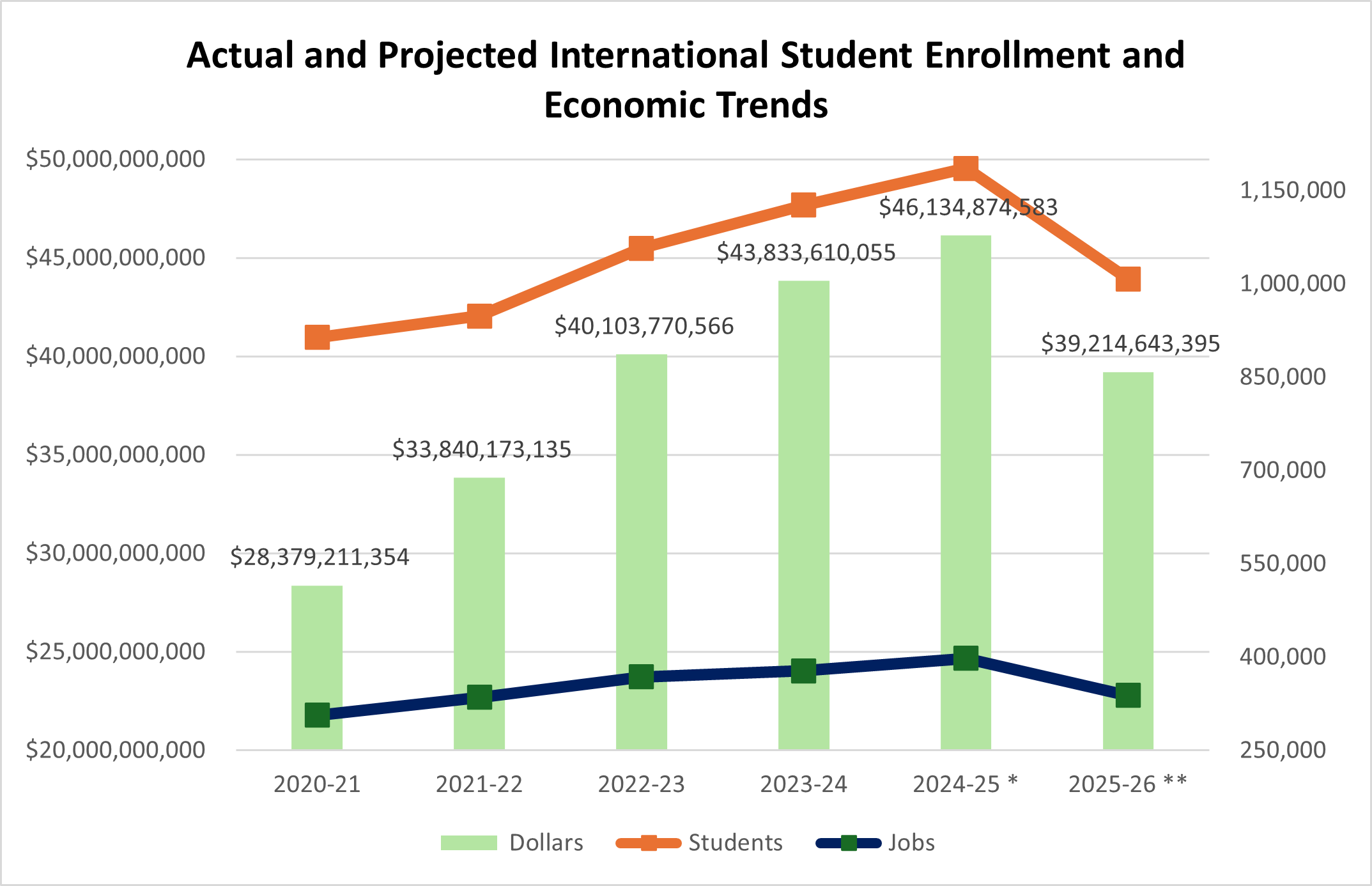Washington, D.C. — Preliminary projections by NAFSA: Association of International Educators and JB International reveal that recent actions such as visa bans and disruptions in visa interviews and processing could have a devastating effect on U.S. local economies. An analysis of SEVIS and State Department data predicts a potential 30–40 percent decline in new international student enrollment, contributing to a 15 percent drop in overall enrollment this fall. Such an outcome would deprive local economies of $7 billion in spending and more than 60,000 jobs.
“This analysis, the first to calculate the potential economic impact of fewer international students on cities and towns across the country, should serve as a clarion call to the State Department that it must act to ensure international students and scholars are able to arrive on U.S. campuses this fall,” said Fanta Aw, executive director and CEO of NAFSA: Association of International Educators. “The immediate economic losses projected here are just the tip of the iceberg. International students drive innovation, advance America’s global competitiveness, and create research and academic opportunities in our local colleges that will benefit our country for generations. For the United States to succeed in the global economy, we must keep our doors open to students from around the world.”
Factors Driving the Decline
- Visa Interview Suspension: Between May 27 and June 18, 2025, student visa interviews were paused during the peak issuance season for students seeking to enroll in a U.S. institution this fall. As announced on June 18, the resumption of interviews carried a directive that U.S. consulates implement new social media vetting protocols within five days—with scant guidance provided. This vague and unnecessary administrative burden taxes a system that was already struggling with visa processing appointment scheduling delays.
- Limited Appointment Availability: There are reports of limited or no appointments for international students at consulates in India, China, Nigeria, and Japan, among others. India and China are the top two international student-sending countries to the United States; Nigeria is seventh and Japan is 13th.
- Downward Visa Trends: F-1 visa issuance is down 12 percent from January to April 2025 and down 22 percent in May 2025 compared to May 2024. June 2025 F-1 issuance data has not been published but a decrease of 80–90 percent is possible based on the factors identified here.
- Visa Bans: Restrictions targeting 19 countries as of a June 4, 2025, executive order, with another 36 rumored to be added, threaten $3 billion in annual contributions and more than 25,000 American jobs.
The Bottom Line: Without significant recovery in visa issuance in July and August, up to 150,000 fewer students may arrive this fall.
Policy Solutions
To mitigate this devastating outcome for cities, towns, and institutions, NAFSA urges the State Department to:
- provide expedited visa appointments and processing for all F-1 and M-1 students and J-1 exchange visitor visa applicants; and
- exempt F and M students as well as J exchange visitors from the travel restrictions currently banning the entry of nationals from 19 countries while maintaining background checks and vetting required for visa issuance.
For More Information
To explore a state-level analysis of the fall 2025 international enrollment projections and anticipated economic decline, visit nafsa.org//fall2025report.
About the Methodology
JB International based its 2024–25 projected enrollment estimation on SEVIS by the Numbers data and the State Department’s Bureau of Educational and Cultural Affairs Annual J-1 Exchange Visitor Report, which has a 96 percent alignment to the Open Doors international student enrollment data expected in November 2025. The 15 percent enrollment reduction predicted for 2025–26 is based on current visa restrictions, State Department Monthly Nonimmigrant Visa Issuance Statistics for incoming students (currently available only through May 2025), SEVIS by the Numbers data for active students, and the NAFSA International Student Economic Value Tool powered by JB International.
About NAFSA: Association of International Educators
NAFSA: Association of International Educators is the world’s largest and most comprehensive nonprofit association dedicated to international education and exchange. NAFSA promotes policies that ensure the continued growth and impact of global learning, cultural exchange, and mutual understanding through study abroad, international student services, and campus internationalization. With a network of more than 10,000 professionals in the field at more than 4,000 institutions in more than 150 countries, NAFSA is committed to fostering a more globally connected and peaceful world. nafsa.org.
About JB International
JB International is the team behind Trilby Suite, a modern case management platform that helps institutions manage international employees, scholars, and students while meeting complex regulatory requirements. With over 60 years of combined experience in international education and immigration compliance, JB International also leads research and data initiatives that support the field at large. jb.international/

